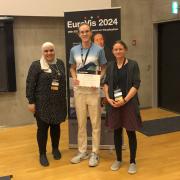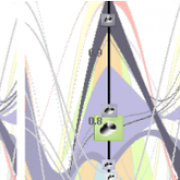Wider research context
In many domains, such as biology, chemistry, medicine, and the humanities, large amounts of data exist. Visual exploratory analysis of these data is often not practicable due to their size and their unstructured nature. Traditional machine learning (ML) requires large-scale labeled training data and a clear target definition, which is typically not available when exploring unknown data. For such large-scale, unstructured, open-ended, and domain-specific problems, we need an interactive approach combining the strengths of ML and human analytical skills into a unified process that helps users to "detect the expected and discover the unexpected".
Hypotheses
We hypothesize that humans and machines can learn jointly from the data and from each other during exploratory data analysis. We further hypothesize that this joint learning enables a new visual analytics approach that reveals how users' incrementally growing insights fit the data, which will foster questioning and reframing.
Approach
We integrate interactive ML and interactive visualization to learn about data and from data in a joint fashion. To this end, we propose a data-agnostic joint human-machine data exploration (JDE) framework that supports users in the exploratory analysis and the discovery of meaningful structures in the data. In contrast to existing approaches, we investigate data exploration from a new perspective that focuses on the discovery and definition of complex structural information from the data rather than primarily on the model (as in ML) or on the data itself (as in visualization).
Innovation
First, the conceptual framework of JDE introduces a novel knowledge modeling approach for visual analytics based on interactive ML that incrementally captures potentially complex, yet interpretable concepts that users expect or have learned from the data. Second, it proposes an intelligent agent that elicits information fitting the users' expectations and discovers what may be unexpected for the users. Third, it relies on a new visualization approach focusing on how the large-scale data fits the users' knowledge and expectations, rather than solely the data. Fourth, this leads to novel exploratory data analysis techniques -- an interactive interplay between knowledge externalization, machine-guided data inspection, questioning, and reframing.
Primary researchers involved
The project is a joint collaboration between researchers from TU Wien (Manuela Waldner) and the University of Applied Sciences St. Pölten (Matthias Zeppelzauer), Austria, who contribute and join their complementary expertise on information visualization, visual analytics, and interactive ML.
FWF Stand-alone project P 36453
DOI: 10.55776/P36453
Links
Source code for all sub-projects: GitLab
Project page from funding agency: JDE@FWF
Online Demos
We have small online demos to demonstrate our research results. All demos are based on the Joint Human-Machine Data Exploration Sandbox [code][technical report][documentation][demo]. To create a new instance of the sandbox, clone the demo session and enter a suffix name to store the new session. The following demos are currently available:
Flexible Interactive Labeling
Using the well-known and simple Fashion MNIST dataset, we show a proof-of-concept for interactive class-incremental, hierarchical learning using the principle of visual interactive labeling.
https://sandbox.jde.cg.tuwien.ac.at/login
Visual Bias Explorer
We used the sandbox as technical foundation to explore visual bias in generative text-to-image models [paper]. Our demo supports three bias scenarios: gender bias (man vs. woman), racial bias (Latino vs. Caucasian), and geographical bias (Germany vs. Nigeria), which can be explored using Stable Diffusion 3 as text-to-image model. To start a new exploration session, clone one of these three sessions. The session starts with a prompting tree including the two anchor concepts. Use the prompting tree to add any test concept.
Funding
- FWF Fonds zur Förderung der wissenschaftlichen Forschung (FWF)
Project Partner
Team
News
Research Areas
- In this research area, our focus lies on novel visual encodings and interaction techniques to explore a large amount of abstract data, often in combination with analytical reasoning.
Publications
| Image | Bib Reference | Publication Type |
|---|---|---|
| 2025 | ||
 |
Matthias Matt, Jana Sedlakova , Jürgen Bernard, Matthias Zeppelzauer, Manuela Waldner , Jürgen Bernard, Matthias Zeppelzauer, Manuela Waldner Scalable Class-Centric Visual Interactive Labeling COMPUTERS & GRAPHICS-UK, 129, June 2025. |
Journal Paper (without talk) |
 |
Johannes Eschner , Roberto Labadie‐Tamayo , Roberto Labadie‐Tamayo , Matthias Zeppelzauer, Manuela Waldner , Matthias Zeppelzauer, Manuela Waldner Interactive Discovery and Exploration of Visual Bias in Generative Text‐to‐Image Models Computer Graphics Forum, 44(3):e70135, June 2025. [  paper] [live demo] paper] [live demo] |
Journal Paper with Conference Talk |
| Mario Stoff Prototypical Visualization: Using Prototypical Networks for Visualizing Large Unstructured Data [  thesis] thesis] |
Master Thesis | |
| 2024 | ||
 |
Dominik Wolf Joint Human-Machine Data Exploration Sandbox [  report] [GitLab] [demo] report] [GitLab] [demo] |
Student Project |
 |
Matthias Matt, Matthias Zeppelzauer, Manuela Waldner cVIL: Class-Centric Visual Interactive Labeling In Eurographics Proceedings. May 2024. [paper] [GitLab] |
Conference Paper |
| Max Irendorfer User Approaches to Knowledge Externalization in Visual Analytics of Unstructured Data [  thesis] thesis] |
Master Thesis | |
| Dominik Eitler Spatial Organization Strategies in Exploratory Analysis of Unstructured Data [  thesis] thesis] |
Master Thesis | |
| 2023 | ||
 |
Judith Louis-Alexandre Dit Petit-Frere, Manuela Waldner Visual Exploration of Indirect Bias in Language Models In EuroVis 2023 - Short Papers. June 2023. [  paper] [ paper] [ video] [online demo] video] [online demo] |
Conference Paper |
 |
Gerald Kimmersdorfer, Dominik Wolf, Manuela Waldner WebGPU for Scalable Client-Side Aggregate Visualization Poster shown at 25th EG Conference on Visualization (EuroVis 2023) (12. June 2023-16. June 2023) In EuroVis 2023 - Posters , pages 105-107. [  extended abstract] [ extended abstract] [ poster] [Climate Change Explorer] poster] [Climate Change Explorer] |
Poster |


